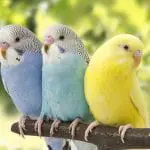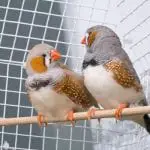In the past, parrot breeders are used to feeding their pets with a seed-based diet only, but as time goes by, where there is a lot of innovations when it comes to the agricultural setting, there are researches made about formula feeds as an excellent substitute for seed diet. Formula pellets are a better option for your parrot because it is made to contain a complete set of the needed vitamins and minerals needed by the parrot to live healthily. The parrot’s diet is comprised of at least 80% of pellets and only 15% fresh fruits and vegetables and about 5% allocated for treats. You may need to consult your veterinarian if you are not sure about the kind of pelleted mixes to give your pet.
Is Pellets the Better Option for your Parrot?
There are two based foods that are given to parrots and other bird species, which are seed and pelleted diets. Parrots both love to feed on these diets, but it was found out that seeds are in general high in fat and only contain low amounts of needed vitamins and minerals, considering it as their junk food. Seeds are the parrot’s favorite; that is why if you mix the seeds with some nutritional nutrients such as fruits and vegetables, except that they will still choose to eat the seeds.
To avoid wasting the other food nutrients that you are giving them, pelleted mixes were invented. Bird pellets are a mixture of seeds, fruits, vegetables, nuts, oats, and anything a bird feeds on in the wild. A single pellet already contains a mixture of nutrients needed by the parrot so you can be sure that they are getting a balanced diet.
Benefits of Pelleted Feeds

1. More nutritious
When your parrot is given nutritious food, expect that it will happily live longer. Parrots tend to be a picky eater, in a bowl with different kinds of food, you can be sure that they’ll pick on primarily the seed ones, but if it is in pelleted form, your bird doesn’t have a choice but to feed on everything that is incorporated on the pellets. Pellets comprise of different food products that contain specific vitamins and nutrients, pretty much the same as what they have in their natural habitat.
2. Easier to clean
There is less cleaning for you since pellets are all edible and 100% digestible, unlike seed mixes where there are particles included from corn and other crop products that are not eaten by the parrot and will just stay in their food bowls as a waste.
3. Healthy looking parrot inside and out
One of the prominent ingredients of pellets is amino acids, which are a vital ingredient for bone and feather development as well as aids in the functioning of the immune system. As soon as you switch your parrot’s diet into a pelleted diet, you’ll notice the change in their overall health condition inside and out.
How to Switch a Seed-Based Diet into a Pelleted-Based Diet

If your parrot has been used to the seed-based diet and you want to switch their diet plan into a quality commercial food or pelleted-based diet, there are some pointers to consider. It may take some time and effort, but if you would introduce to the parrot their new food in a correct manner, you can be sure that it will not be a difficult process. These are some of the guidelines before switching your parrot’s diet.
a. Consult with your veterinarian
There are different possible reasons why you want to change your parrot’s diet plan; it may be because of your decision, or it is what your veterinarian told you to do so. If it is just your own decision, you still need to consult your veterinarian to see if your desired diet plan is applicable to your parrot. The veterinarian would examine your parrot physically if it is healthy most likely you can change their diet because its body can make the changes.
The veterinarian can also formulate a diet plan that you can use that is enriched with nutrients to ensure that your parrot will positively take the new diet plan. The usual case wherein a veterinarian formulates a diet plan is if your bird is overweight or obese.
b. Decide the kind of pellet-based diet
There are different kinds of formulated diets; may it be in the form of a crumble, nuggets, and pellets, but the usual formula diet is the pelleted ones. These are available in pet stores, veterinarians, manufacturers and internet retailers. These readily available foods depend on what kind of bird species you have, that is why you need to ensure that the chosen one is applicable to your parrot. Consult your veterinarian if you are not yet sure about the formulation that can be used with your parrot. Always start with small quantities to know if there are adverse reactions.
c. Determine your parrot’s food intake
Before deciding to change your parrot’s diet, be familiarize with their feeding pattern as well as how much is the average amount of food intake, your parrot usually eats per day. You also need to account for the number of seeds that are left on their food dish so that you or your veterinarian can be accurate in formulating their new diet.
d. Check your parrot’s weight
There is a possibility that your parrot will reluctantly eat the new formula diet that you will be giving for a couple of days so their weight should be at the optimum level before shifting diets to ensure that your bird will not lose weight rapidly if in case your bird will still adjust. Make sure that your parrot will not lose up to 2% weight per week. Your parrot’s weight is the one affected if the shift of diet is not incorporated well.
How to Make a DIY Parrot Pellets

If you are on a tight budget, you can create your own version of pellets from different kinds of grains, vegetables, grasses, etc. You are not sure about the ingredients that are on the bird pellets that you can see in the market, but if you create your own, you can be sure that the pellets that you will feed your parrot are healthy and safe. You just need to have base ingredients and a pellet press.
Step 1: Know the vitamins, minerals, nutrients, and kind of food that is applicable to the bird since it will be your base ingredients. The usual ingredients are wheatgrass, alfalfa, oats, roasted soybeans, shelled corn, fruits, and vegetables.
Step 2: Once the desired ingredients are prepared, place them all in a food processor. To keep it healthy, add necessary vitamin supplements that are needed, such as vitamin A, vitamin E, vitamin 12, calcium, riboflavin, and niacin.
Step 3: Once all the products have been incorporated, add about 1 tbsp. of a natural preservative for every 16 oz. of pellet ingredients. The different kinds of preservatives that you can use are citrus peel extract, salt, and rosemary extract.
Step 4: Make sure that the overall ingredients are powdered before placing it in a hopper of a pellet press. The pellet press should be in the high setting.
Final Thoughts
Understanding the right kind of food to give your parrot is the way to keep them nourished so they won’t starve. If your parrot is enriched with vitamins and nutrients, you can be sure that they have a shield against diseases or illnesses that are prevalent in the avian community today.



